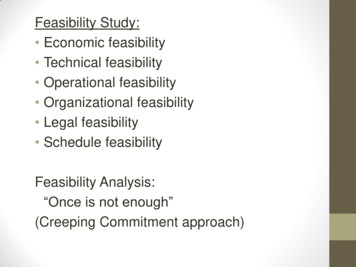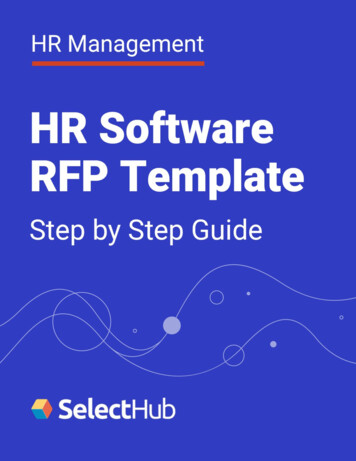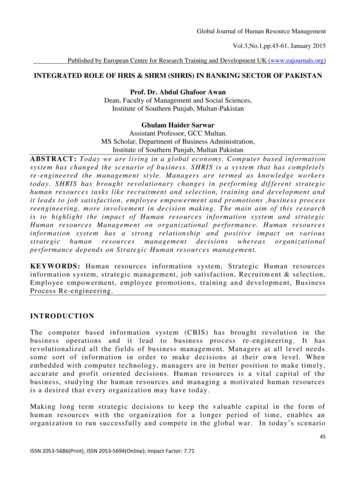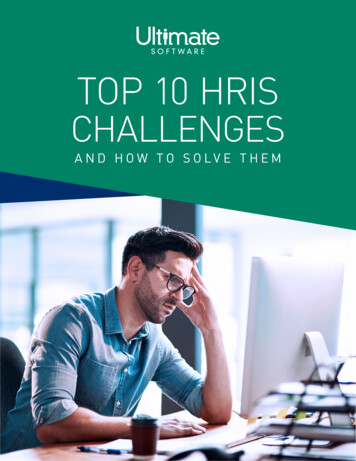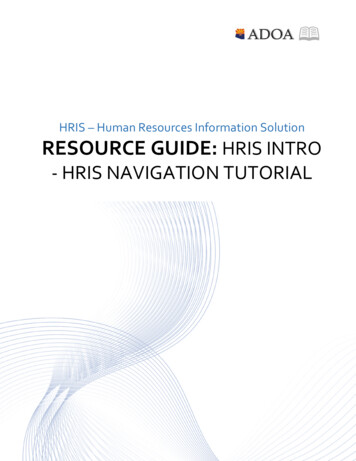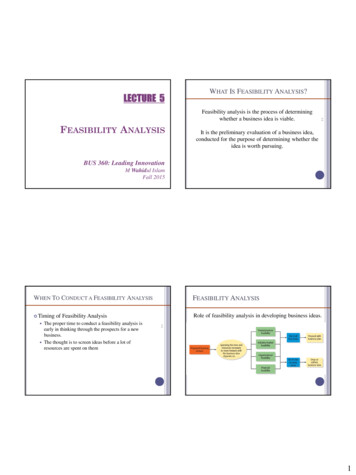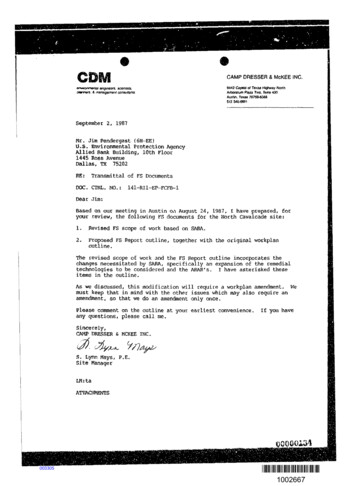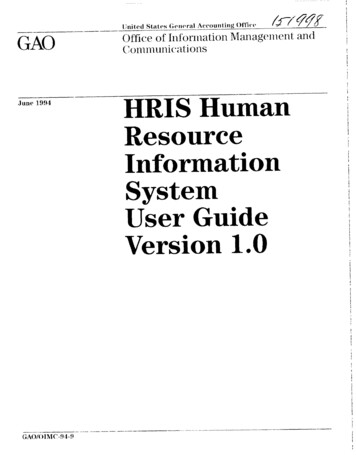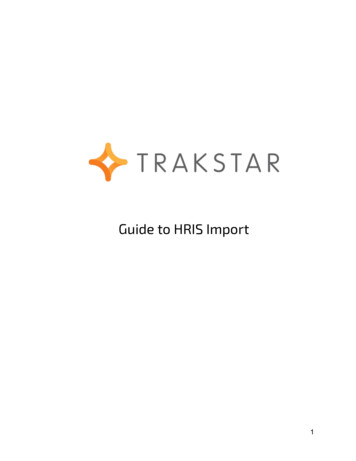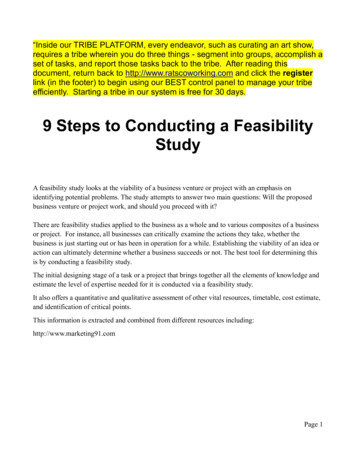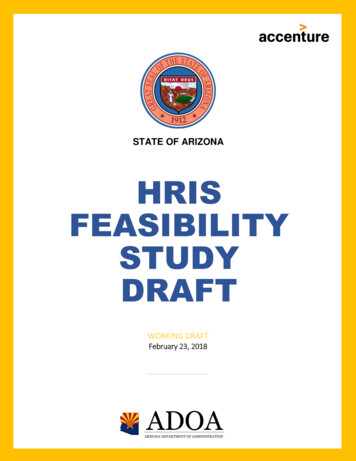
Transcription
STATE OF ruary 23,2018WORKING DRAFTFebruary 23, 2018ADOAARIZONA DEPARTMENT OF ADMINISTRATION
Arizona HRIS Feasibility Study Executive Summary – DRAFT REPORTFebruary 23, 20181 Executive SummaryReference: Task Order element 3.1.2(a)The Arizona Department of Administration (ADOA) has engaged Accenture to complete a feasibilitystudy of the current HRIS system(s) to identify improvement opportunities, options, and arecommended roadmap on how to proceed with HRIS investments that are aligned with the State’sbusiness imperatives and industry leading practices. In developing this report, Accenture carefullyconsidered the State’s strategic direction to operate efficiently as guided, in part, by the ArizonaManagement System and Cloud First initiatives. As such, Accenture conducted numerous businessprocess workshops with ADOA and State agencies, including the Department of Public Safety (ADPS), toidentify improvements, innovation and HRIS options that the State should consider in both the short andlong term.To develop this study Accenture undertook a robust data gathering effort and gained many insights intothe State’s opportunities, challenges and current state. Based on reviews of State strategic plans,interviews, As-Is/To-Be workshops, current state analysis, future state possibilities, market research andAccenture's industry and domain experience, we have identified a recommended roadmap for HRISinvestment options that would enable the State of Arizona to: Deliver more efficient and cost-effective employee services and better attract talent andworkforces of the futureAchieve improved business outcomes and HR performanceStandardize business process and realize more efficient methods for conducting HR work.Improve current, prospective and retired employee experiencesOptimize scheduling and deploying 24x7 workforces, such as public safety and health andhuman services employeesModernize technology system investments pragmatically and address the State’s most pressingHR business needs in a phased approach based on value and alignment with State imperatives.Capitalize on advanced technologies to modernize and optimize how work is done using RoboticProcess AutomationEstablish Human Resource workforce decision support analytical capabilities for more effectiveHR and workforce decisionsUnify the agencies statewide so that individual agencies, like DPS, have the functionality theyneed to not operate in silos. Reduce on-going system maintenance effort and cost1.1 Our FindingsThe findings in this Final Report document information from Accenture’s interim Initial report and adddetails of the "as-is" vs. "to-be" system, detailed evaluation of business processes and the remainingelements identified in the Task Order.There were three key themes we identified as we gathered information for this study; manual processesthat could be standardized and\or automated, shared services that are applicable for all agencies andthat can be modernized, and siloed governance that can be broadened.1
Arizona HRIS Feasibility Study Executive Summary – DRAFT REPORTFebruary 23, 2018Manual ProcessesAccenture has conducted twenty-one executive interviews and sixteen business process workshops withthe individual ADOA HR functional areas, including, MAP, Benefits, HRIS, Recruiting, Classification &Compensation, as well as sub-agencies including ADPS, ADES, ADVS, ADC and other State of Arizonaagencies. We identified that many HR procedures are manual, for example the use of multiple types ofPersonnel Action Forms that are physically and not electronically executed or tracked with casemanagement. ADPS, in particular, has many manual processes that are happening outside of their HRsystem and are creating an urgent need for action.Additional issues and challenges in processes are largely the same across agencies and include, forexample, incomplete applications, excessive handoffs, internal review loops, and a lack of overalltracking. Many of the manual processes could lead to slower responses to citizens and businesses,processing errors and difficulty in detecting fraud, waste and abuse.Shared ServicesEstablishing and operating effective and efficient HRIS shared services positions the State to be moreeconomical with its spend on administrative systems. Optimizing State technology investments isaccomplished by achieving the maximum number of users or agencies that can use those services. Todate, the State has made great stride in establishing shared services through its functions within DOA.In this study Accenture identifies additional opportunities for HR innovation and automation that couldfurther the State’s goal of establishing Shared Services for all agencies.GovernanceThere are many HRIS decisions on the horizon that will require strong governance from ADOA and theagencies. As HRIS Shared Services evolves, some areas that will require broad support include how toestablish data for one "source of truth", make HRIS system investments in innovation that benefit thewhole State, how to modernize and optimize technology architecture, where to improve HR sharedservices and processes, and how to address HRIS issues.1.2 Key Factors to HRIS standardization and modernizationBased on our findings and Accenture’s experience with other organizations’ HRIS modernizationprojects, we have identified the following 10 key factors for Arizona as the State undertakesstandardization and modernization efforts.2
Arizona HRIS Feasibility Study Executive Summary – DRAFT REPORTFebruary 23, 2018Figure 1: Key Challenges with the Arizona HRIS Modernization effort1.3 HRIS System Options RecommendationBased on the business needs and current state of the HRIS, our recommendation is that Arizonapragmatically undertake a series of initiatives to improve HR business processes and implement ormodernize HRIS technologies. Accenture has identified and evaluated six HRIS options to address theHR needs of the State; these range from continuing with the current HRIS vendor system tomodernization using state-of-the-art Cloud based solutions. Based on our analysis, ourrecommendation(s) is to pursue option number six as illustrated in the Options analysis (figure 2) below.However, we are also recommending that the State invest in an upgrade of Lawson to version 10 tomaintain current support of the Lawson vendor software in the near term:1. Establishing a statewide governance model for HRIS that is inclusive of agencies in HRIS innovation,standardization and modernization decisions and actions.2. Implement business process improvements and standardization for the state agencies across tenHuman Capital Management domains.3. Using a phased approach, procure and implement modernized core HRIS functionality from a singleCloud vendor and acquire and implement best-of-breed Cloud vendors capabilities for the extendedfunctionalities. The core HRIS functionalities are Human Resources, Position Control, BenefitsAdministration, Payroll, and Time and Attendance. The extended functionality includes Learning,Recruiting, Scheduling and Time Capturing, and Performance Management.The following are suggested phased executable paths to achieve Option 6:1. Short-term - Upgrade to Lawson version 10 to keep existing statewide HRIS current and to providetime to procure a solution that aligns with the State's longer view of technology in the future.2. Medium-term - Automate priority HCM business processes by implementing Cloud solutions toinitiate early realization of benefits for Learning, Performance Management, and Scheduling and TimeCapturing. This includes any early or incremental changes needed to support the ADPS business.3
Arizona HRIS Feasibility Study Executive Summary – DRAFT REPORTFebruary 23, 20183. Longer-term - Procure and implement a Cloud solution for core HRIS functionalityTech AlignOption 1 – No Business ProcessImprovements & Maintain CurrentSystem Version(s)Option 2 – Business ProcessImprovements and Maintain CurrentSystem Version(s)Option 3 – Business ProcessImprovements and Upgrade to v10 ofLawsonOption 4 – Business ProcessImprovements and Implement v11 ofLawsonOption 5 – Business ProcessImprovements and Implement NewHRIS with no CloudFirstOption 6 – Business ProcessImprovements, Step Solutions andCloudFirstProcessOrg Align User 44444311213Figure 2: Options Analysis1.4 Costs1.4.1 Implementation CostsMost cloud HRIS solutions require specialized consulting skills to implement. These skills include projectmanagement, functional and technical specialists, and integrations specialists. Additionally, the state willneed to provide key staff to support the implementation and several of these positions will need to be“back filled” to allow the resources to focus on the implementation.These costs are estimated, based on Accenture’s experience scoping and implementing cloud solutionsfor state governments, as follows: Full suite HRIS roadmap implementation consulting fees: 20MM - 30MMInternal labor costs plus backfill(s): 10MM- 15MM4
Arizona HRIS Feasibility Study Executive Summary – DRAFT REPORTFebruary 23, 20181.4.2 Roadmap and TimelineFigure 3: Implementation Roadmap5
pragmatically undertake a series of initiatives to improve HR business processes and implement or modernize HRIS technologies. Accenture has identified and evaluated six HRIS options to address the HR needs of the State; these range from continuing with the current HRIS vendor system to modernization using state-of-the-art Cloud based solutions.
